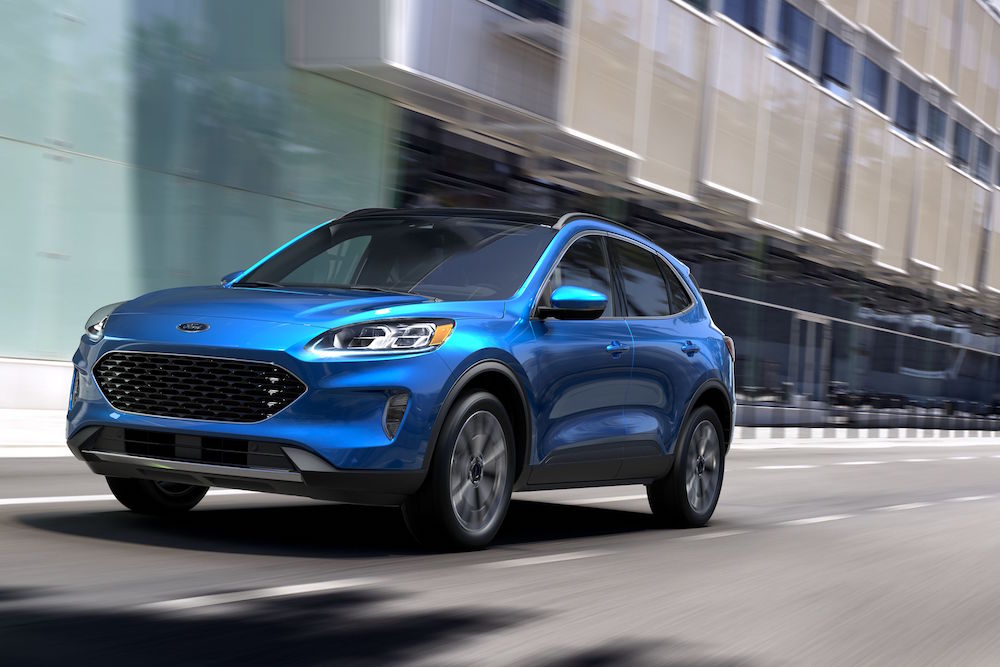2020 Ford Escape unveiled with a new look and two Hybrid options

With today’s reveal of the stylish new Escape, featuring the small SUV’s best-ever performance, flexibility and smart new technology, Ford is reinventing the model that helped drive the popularity of the segment.
Escape, which debuted the world’s first hybrid SUV in 2005, brings back two hybrid choices for 2020, a standard hybrid and a plug-in variant, and introduces technologies ranging from drive modes and driver-assist features to electric vehicle ingenuity and on-board connectivity.
“This all-new Escape brings a sleeker, sportier design with the capability to take you on just about any of your life’s adventures,†said Kumar Galhotra, Ford’s president, North America. “With our class-leading hybrid powertrains, customers will spend less time at the gas station and more time on the road.â€
To create a sportier look for the all-new Escape, designers turned to some of the most high- profile sports cars in the Ford showroom. The shield-shaped trapezoidal grille is inspired by the sixth-generation Mustang, while the lower front end borrows from Ford GT. Compared to the current model, the all-new Escape stands lower, wider and longer.
With a sloped roofline, optimized liftgate spoiler and strake, and efficient underbody, the all-new Escape is the most aerodynamic to date. Meanwhile, it sheds more than 90 kilograms (200 pounds) from the current model, due in part to the extensive use of high-strength, lightweight steel.
Every model in the lineup, whether powered by one of two EcoBoost engines or the all-new hybrid powertrains, targets an EPA-estimated range of at least 640 kilometeres per tank. The standard hybrid with front-wheel drive targets best-in-class EPA-estimated range of more than 885 kilometres.
Best-performing Escape ever
New powertrains and transmission systems, a reduction in weight, improved aerodynamics and updated suspension system all contribute to one undeniable fact: this is the best-performing, most fun-to-drive Escape ever.
Gas engine-powered models as well as the standard hybrid are available with all-wheel drive. EcoBoost-equipped models get a new quick-shifting 8-speed automatic transmission for smooth, responsive shifting, while every Escape receives an all-new suspension and improved isolation with a new isolated rear subframe.
“This new vehicle performs like no other Escape before,†said Jim Hughes, Escape chief program engineer. “It’s quick, it’s responsive and, in staying true to the standard set by three generations of Escapes before it, it’s a heck of a lot of fun to drive.â€
The new 2.0-litre EcoBoost engine, available on SEL and Titanium is projected to produce 250 horsepower and 275 lb.-ft. of torque using 93 octane fuel, while turning in a 0-100 km/h time up to 10 per cent faster than the outgoing Escape 2.0-litre. When properly configured, it is rated to tow almost 1,600 kilograms (3500 pounds).
The all-new 1.5-litre EcoBoost, standard on S, SE and SEL, is projected to produce 180 horsepower and 177 lb.-ft. of torque using 93 octane fuel. When properly configured, it is rated to tow more than 900 kilograms (2000pounds). To help conserve fuel, the 1.5-litre EcoBoost debuts cylinder deactivation, a Ford first for North America, which senses when one cylinder isn’t needed and shuts it down automatically. The system can activate or deactivate a cylinder in 14 milliseconds to maintain a smooth ride.
Titanium model come standard with Ford’s innovative fourth-generation hybrid propulsion system, which includes an all-new 2.5-litre Atkinson cycle hybrid engine and electronic continuously variable transmission. The front-wheel-drive hybrid model is projected to produce a combined system horsepower of 198, and a top speed of 137 km/h in electric-only mode.
The plug-in hybrid variant, available on every trim level except S, projects a best-in-class range of at least 48 kilometres in electric-only mode. Escape Plug-In Hybrid has a Level 1 / Level 2 AC charging port. Using a 110-volt Level 1 charge, the estimated time to fully charge the battery is 10 to 11 hours. Using a 240-volt Level 2 charge, charge time drops to roughly 3.5 hours.
Hybrid models feature four EV modes that allow customers to select the settings most suitable for their individual needs. This means:
- In Auto EV mode, the vehicle decides whether to run on gas or electric power
- In EV Now mode, drivers can operate on all-electric driving
- In EV Later mode, drivers can switch to full gas-powered driving to conserve electric kilometres for later
- In all-new EV Charge mode, drivers can continue to charge the battery while driving and generate electric-only kilometres to use later